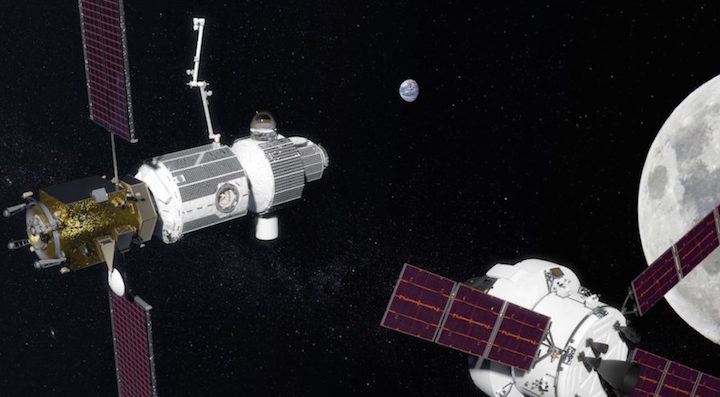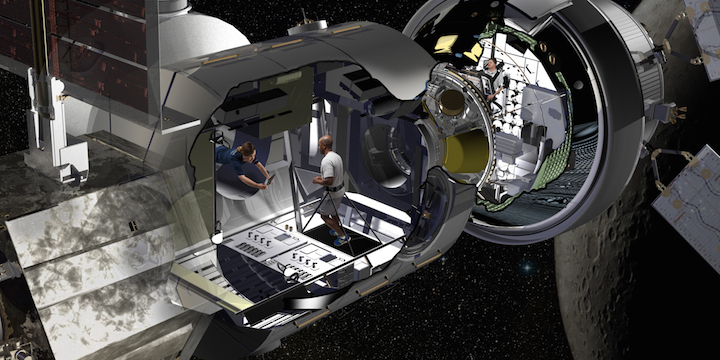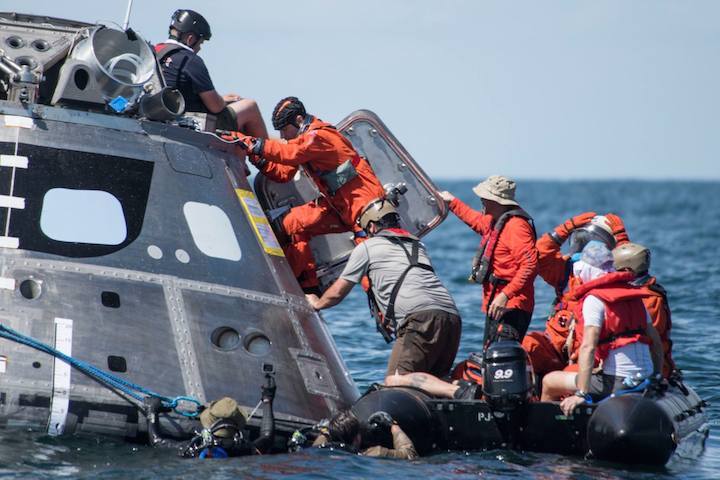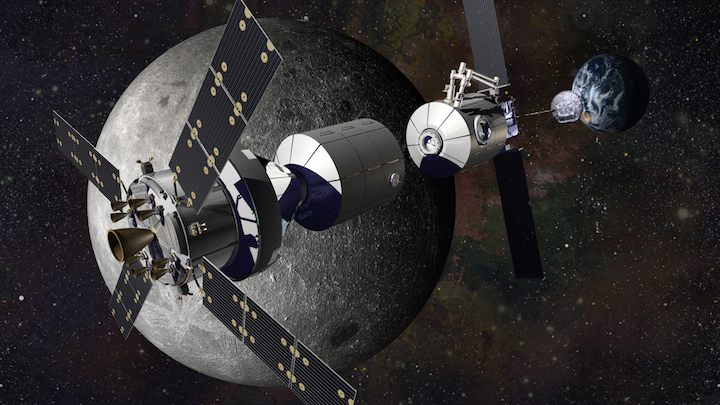20.07.2017
NASA seeks information on developing Deep Space Gateway module

WASHINGTON — NASA is taking the next small step in the development of a proposed Deep Space Gateway in cislunar space by requesting information about one of its core modules.
A request for information (RFI), released by NASA July 17, seeks information from industry regarding their capabilities to build a Power and Propulsion Element (PPE), a module that will produce electrical power and provide chemical and electrical propulsion for the gateway.
As currently envisioned by NASA, the PPE would be the first element of the gateway, launched as a “co-manifested payload” on the first crewed Space Launch System launch, taking advantage of the additional payload capacity provided by the Block 1B version of the SLS. The PPE would go into what is known as a near rectilinear halo orbit around the moon within 100 days of launch.
The RFI describes the basic capabilities and requirements of the PPE as envisioned by NASA. The module would have a 15-year lifetime and be equipped with a solar electric propulsion system that uses xenon propellant, as well as chemical thrusters that use hydrazine. The module would weigh no more than 7,500 kilograms in order to be a co-manifested SLS payload, including a tank carrying 2,000 kilograms of xenon.
The PPE will produce electrical power, being able to transfer up to 24 kilowatts to other modules later added to the gateway. It will also support communications in several bands, as well as an optical communications demonstration payload.
In the RFI, NASA asks potential respondents their ability to produce the PPE, including a “conceptual schedule, rough order of magnitude engineering cost estimate, and recommended contract vehicle” for it. NASA expects to have the PPE delivered to the Kennedy Space Center for integration onto the SLS in December 2021, which would support a launch of the Exploration Mission 2 flight now expected for some time in 2022.
NASA hopes that the module can build on early design work for the Asteroid Redirect Mission, whose robotic spacecraft would have also used solar electric propulsion to travel to and from a near Earth asteroid. “Identify a conceptual design you would use as a starting point and what changes you believe are warranted to address PPE capability statements,” NASA instructs industry in the RFI.
NASA also asks industry to address several other issues in the RFI. These range from the potential use of green propulsion alternatives for the hydrazine thrusters on the spacecraft and the use of a commercial spacecraft bus for the module to discussion of potential cost-sharing approaches for its development.
“Through the RFI, we hope to better understand industry’s current state-of-the-art and potential future capabilities for deep space power and propulsion,” said Michele Gates, director of the PPE effort at NASA Headquarters, in an agency statement. Gates formerly was director of the Asteroid Redirect Mission program.
The agency is moving quickly with the RFI. Released July 17, NASA seeks responses by the end of the day July 28. The agency will conduct a question-and-answer session online about the RFI July 24.
In addition to the RFI, NASA plans to release a broad area announcement in August, under its existing Next Space Technologies for Exploration Partnerships (NextSTEP) program, related to development of the PPE. That announcement will seek proposals for short-term studies to address technical issues involving the PPE, including its power and propulsion systems as well as other key subsystems.
The RFI and planned NextSTEP studies are NASA’s next tentative steps in the development of the Deep Space Gateway concept. NASA describes the gateway as “a lunar-orbiting, crew-tended spaceport” that would also include a habitation module and docking ports for the Orion crew spacecraft and separate cargo spacecraft. The gateway’s additional modules would also be delivered to cislunar space as co-manifested payloads on future SLS launches.
Crews would visit the gateway on Orion missions, spending up to several weeks there before returning. The PPE would allow the gateway to change orbits, including moving closer to the moon to support any potential later missions on the lunar surface.
NASA also foresees using the gateway to support the Deep Space Transport, a future spacecraft that would carry crews into deep space in preparation for Mars missions NASA seeks to fly in the 2030s.
The gateway and the transport, though, are currently only concepts and not formal NASA programs. The gateway remains under study, and NASA did not request funding for it as a standalone program as part of its fiscal year 2018 budget request.
Quelle: SN
---
Update: 21.07.2017
.
Lockheed's Prototype Habitat Plans for NASA's Lunar Orbiting Deep Space Gateway

Artist rendering of the NextSTEP habitat docked with Orion in cislunar orbit as part of a concept for the Deep Space Gateway. Orion will serve as the habitat’s command deck in early missions, providing critical communications, life support and navigation to guide long-duration missions. Credits: Lockheed Martin
-
Last summer, NASA selected six companies to develop prototypes and concepts for deep space habitats for future crews flying missions on Orion. Lockheed Martin was one of them, and this week the company released some details on plans for their full-scale prototype, which they hope to complete over the next 18 months.
Lockheed is developing the prototype under a Phase II contract with NASA’s Next Space Technologies for Exploration Partnerships (NextSTEP) program, as part of the space agency’s plans to build a crew tended spaceport in lunar orbit within the first few SLS / Orion missions known as the “Deep Space Gateway”.

When astronauts return to Earth from destinations beyond the moon in NASA’s Orion spacecraft and splashdown in the Pacific Ocean, they’ll still need to safely get out of the spacecraft and back on dry land. Using the waters off the coast of Galveston, Texas, a NASA and Department of Defense team recently tested Orion exit procedures in a variety of scenarios. Credit: NASA
-
“The deep space gateway would have a power bus, a small habitat to extend crew time, docking capability, an airlock, and serviced by logistics modules to enable research,” says NASA. “The propulsion system on the gateway mainly uses high power electric propulsion for station keeping and the ability to transfer among a family of orbits in the lunar vicinity. The three primary elements of the gateway, the power and propulsion bus and habitat module, and a small logistics module(s), would take advantage of the cargo capacity of SLS and crewed deep space capability of Orion. An airlock can further augment the capabilities of the gateway and can fly on a subsequent exploration mission. Building the deep space gateway will allow engineers to develop new skills and test new technologies that have evolved since the assembly of the ISS.”
“It is easy to take things for granted when you are living at home, but the recently selected astronauts will face unique challenges,” said Bill Pratt, Lockheed Martin NextSTEP program manager. “Something as simple as calling your family is completely different when you are outside of low Earth orbit,” he added.
“While building this habitat, we have to operate in a different mindset that’s more akin to long trips to Mars to ensure we keep them safe, healthy and productive.”
Such an outpost will give astronauts opportunity to build and begin testing the systems needed for the very challenging missions to Mars that NASA has its eyes set on in the coming decades. It offers a true deep space environment to gain experience and land on the moon’s surface for robotic missions; but with the ability to return to Earth if needed in days – rather than weeks or months on missions further into space in the years following.
Lockheed’s vision takes the old Donatello Multi-Purpose Logistics Module (MPLM), once used in the payload bay of the space shuttles to transfer cargo to the ISS, and refurbishes it to prototype their deep space habitat in the Space Station Processing Facility at Kennedy Space Center in Florida.
“We are excited to work with NASA to repurpose a historic piece of flight hardware, originally designed for low Earth orbit exploration, to play a role in humanity’s push into deep space,” said Pratt. “Making use of existing capabilities will be a guiding philosophy for Lockheed Martin to minimize development time and meet NASA’s affordability goals.”
Lockheed says they will rely heavily on mixed reality prototyping using virtual and augmented reality, to reduce cost and schedule, and identify and solve problems early in the design phase.
The company will build a next-generation deep space avionics integration lab near Johnson Space Center in Houston, Texas too, to demonstrate command and control between the Deep Space Gateway and Orion.

Artist concept of the Deep Space Gateway for NASA. Credit: NASA/Lockheed
“The lab will help reduce risk associated with critical data interfaces between Deep Space Gateway elements and provide an environment for astronauts to train for various mission scenarios,” says Lockheed.
“Because the Deep Space Gateway would be uninhabited for several months at a time, it has to be rugged, reliable and have the robotic capabilities to operate autonomously. Essentially it is a robotic spacecraft that is well-suited for humans when Orion is present,” said Pratt.
Orion will actually serve as the command deck for the gateway early on says Lockheed, “allowing for a safe and practical approach for the incremental build-up of deep space exploration capabilities.” And when no crew is onboard, it will utilize capabilities common to other Lockheed-built spacecraft like Juno and MAVEN.
The other 5 companies selected for prototypes are:
- Bigelow Aerospace of Las Vegas, Nevada
- Boeing of Pasadena, Texas
- Orbital ATK of Dulles, Virginia
- Sierra Nevada Corporation’s Space Systems of Louisville, Colorado
- NanoRacks of Webster, Texas
“I envision different partners, both international and commercial, contributing to the gateway and using it in a variety of ways with a system that can move to different orbits to enable a variety of missions,” said William Gerstenmaier, associate administrator for Human Exploration and Operations at NASA Headquarters in Washington. “The gateway could move to support robotic or partner missions to the surface of the moon, or to a high lunar orbit to support missions departing from the gateway to other destinations in the solar system.”
Quelle: AS
